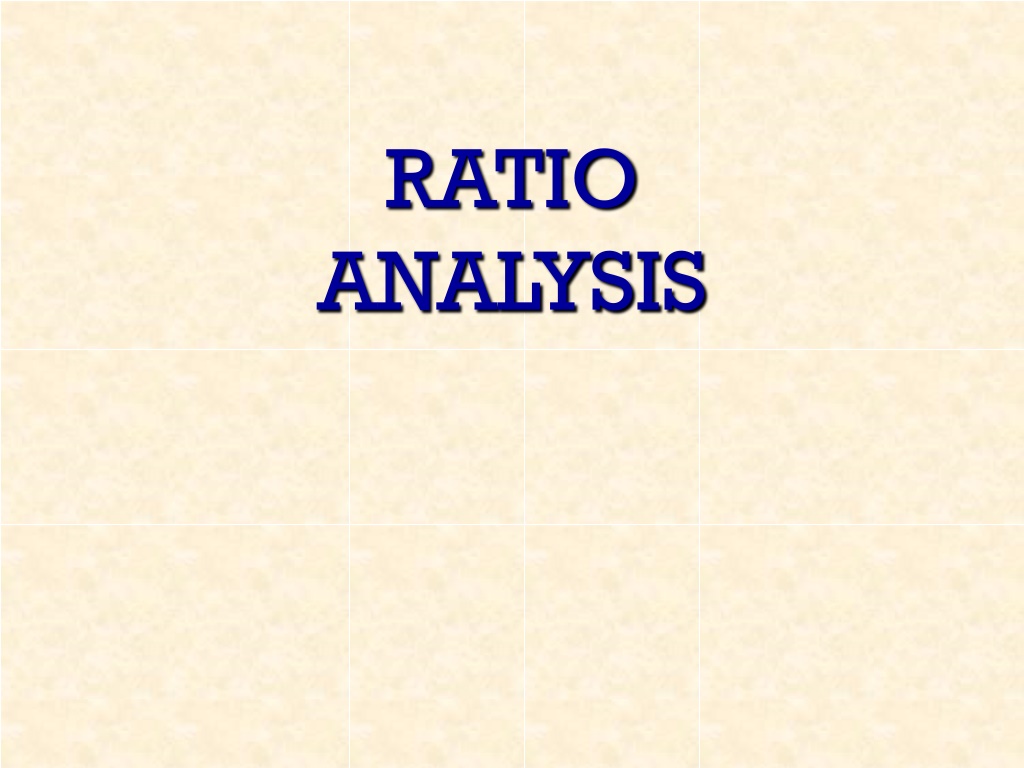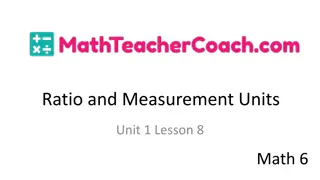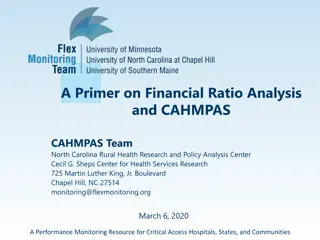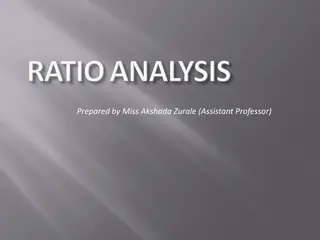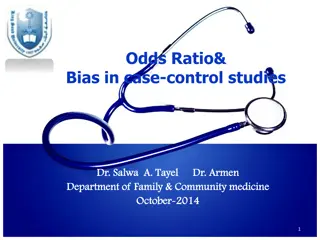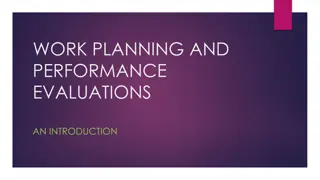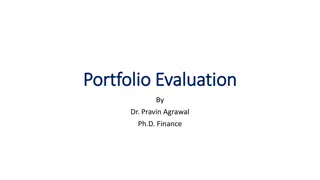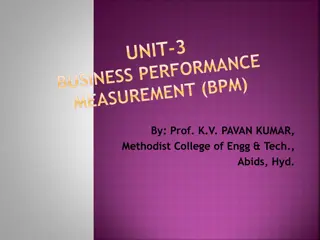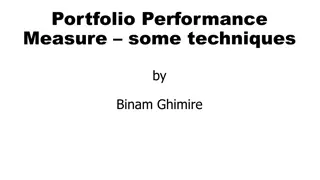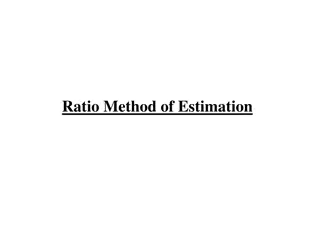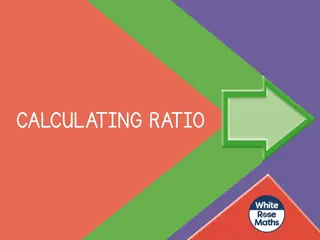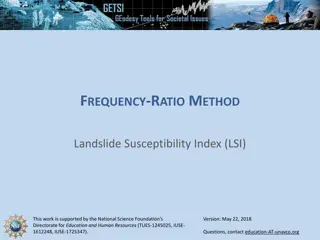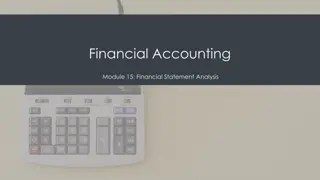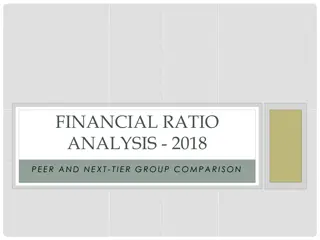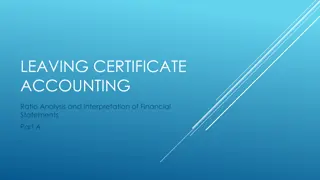Understanding Ratio Analysis for Business Performance Evaluation
Ratios in ratio analysis are crucial for analyzing and comparing business performance over time and against other businesses. They are categorized into profitability, liquidity, and efficiency ratios. Profitability ratios like gross profit percentage, net profit percentage, and return on capital employed offer insights into income statements. Changes in gross profit percentage can be caused by fluctuations in selling prices and cost of sales. Businesses can enhance their gross profit percentage by adjusting mark-ups and managing costs effectively.
Download Presentation

Please find below an Image/Link to download the presentation.
The content on the website is provided AS IS for your information and personal use only. It may not be sold, licensed, or shared on other websites without obtaining consent from the author. Download presentation by click this link. If you encounter any issues during the download, it is possible that the publisher has removed the file from their server.
E N D
Presentation Transcript
RATIO ANALYSIS
RATIO ANALYSIS Ratios can be used analyse a business and to compare the performance of a business between years and with other similar businesses. Ratios can be broadly divided into 3 main types, profitability ratios, liquidity ratios and efficiency ratios.
PROFITABILITY RATIOS USED TO ANALYSE INCOME STATEMENTS The 3 main profitability ratios used to analyse trading profit and loss accounts are the GROSS PROFIT PERCENTAGE NET PROFIT PERCENTAGE RETURN ON CAPITAL EMPLOYED
GROSS PROFIT PERCENTAGE The gross profit percentage of the business A Trader is A Trader Trading, Profit and Loss Account for year ending 31 March 2001 Gross Profit Sales Sales Cost of Sales Gross Profit Expenses Net Profit 250,000 90,000 160,000 100,000 60,000 X 100 = 160,000 250,000 X 100 = = 64%
WHAT CAUSES GROSS PROFIT PERCENTAGE TO CHANGE? A Trader A Trader Trading, Profit and Loss Account for year ending 31 March 2001 Trading, Profit and Loss Account for year ending 31 March 2002 Sales Cost of Sales Gross Profit Expenses Net Profit 250,000 90,000 160,000 100,000 60,000 Sales Cost of Sales Gross Profit Expenses Net Profit 250,000 100,000 150,000 100,000 50,000 The gross profit percentage fell for the above business from 64% to 60%. Changes in this ratio can only come about when there is a change in the selling price and or a change in the price of goods bought for sale. For A Trader the gross profit percentage decreased because cost of sales increased.
HOW CAN A BUSINESS IMPROVE ITS GROSS PROFIT PERCENTAGE? A business can improve its gross profit percentage by increasing the mark-up. Mark-up is the amount added to the cost price of goods to arrive at their selling price, or put more simply by increasing selling price. Gross profit % can also be improved by paying a lower price for goods purchased and by keeping selling price the same or making it higher. Year Cost Mark-up Selling Price Gross Profit Gross Profit % Price 1 2 1 3 1 33% 2 2 2 4 2 50% 3 1 3 4 3 75%
NET PROFIT PERCENTAGE Profit for the Year Sales Net Profit % = X 100 This ratio tells us how much net profit is being made on each 1 of sales, eg if net profit is 15% then 15 p has been made on each 1 of sales.
NET PROFIT PERCENTAGE The net profit percentage of the business A Trader is A trader Trading, Profit and Loss Account for year ending 31 March 2001 Net Profit Sales Sales Cost of Sales Gross Profit Expenses Profit for the year 250,000 90,000 160,000 100,000 60,000 = X 100 60,000 250,000 X 100 = = 24%
WHAT CAUSES NET PROFIT PERCENTAGE TO CHANGE? A Trader A Trader Trading, Profit and Loss Account for year ending 31 March 2001 Trading, Profit and Loss Account for year ending 31 March 2002 Sales Cost of Sales Gross Profit Expenses Net Profit 250,000 90,000 160,000 100,000 60,000 Sales Cost of Sales Gross Profit Expenses Net Profit 260,000 100,000 160,000 90,000 70,000 The net profit percentage improved from 24% to 27%. Net profit percentage can change when anything which affects net profit changes ie changes in gross profit, changes in sales revenue and or changes in expenses.
HOW CAN A BUSINESS IMPROVE ITS NET PROFIT PERCENTAGE? A Trader A Trader Trading, Profit and Loss Account for year ending 31 March 2001 Trading, Profit and Loss Account for year ending 31 March 2002 Sales Cost of Sales Gross Profit Expenses Net Profit 250,000 90,000 160,000 100,000 60,000 Sales Cost of Sales Gross Profit Expenses Net Profit 260,000 100,000 160,000 90,000 70,000 A business can improve its net profit percentage by taking actions which will improve its sales income eg through increased and improved advertising and promotion, or by changes in price. It could also reduce expenses.
Below are details of A Carters Accounts. For Year 1 and Year 2 calculate Gross Profit Percentage and Net Profit Percentage. Explain any changes in these figures. Sales (net) Cost of goods sold Opening inventory Closing inventory Expenses Opening capital Current assets Current liabilities Year 1 000 432 300 38 46 78 360 216 80 Year 2 000 540 390 46 52 105 414 225 50
Below are details of A Carters Accounts. For Year 1 and Year 2 calculate Gross Profit Percentage and Net Profit Percentage. Explain any changes in these figures. Sales (net) Cost of goods sold Gross Profit Gross Profit % Expenses Profit for the year Net Profit % Year 1 000 432 300 132 31% 78 54 13% Year 2 000 540 390 150 28% 105 45 8%
Below are details of A Ford Accounts. For Year 1 and Year 2 calculate Gross Profit Percentage and Net Profit Percentage. Explain any changes in these figures. You will need to calculate Gross Profit and Net Profit first. Year 1 000 756 550 70 80 136 630 380 150 Year 2 000 945 675 80 100 182 700 400 90 Sales (net) Cost of goods sold Opening inventory Closing inventory Expenses Opening capital Current assets Current liabilities
Below are details of A Ford Accounts. For Year 1 and Year 2 calculate Gross Profit Percentage and Net Profit Percentage. Explain any changes in these figures. You will need to calculate Gross Profit and Net Profit first. Year 1 000 756 550 Year 2 000 945 675 Sales (net) Cost of goods sold Gross Profit Gross Profit % Expenses Profit for the year Net Profit % 136 182
Below are details of A Ford Accounts. For Year 1 and Year 2 calculate Gross Profit Percentage and Net Profit Percentage. Explain any changes in these figures. You will need to calculate Gross Profit and Net Profit first. Year 1 000 756 550 206 27% 136 70 9% Year 2 000 945 675 270 29% 182 88 9% Sales (net) Cost of goods sold Gross Profit Gross Profit % Expenses Profit for the year Net Profit %
RETURN ON CAPITAL EMPLOYED Profit for the year Capital at start Return on Capital Employed = X 100 The return on capital percentage tells us how much profit a business has made as a percentage of the capital invested in it and gives an indication of how profitable the business is. The higher the percentage the more profitable the business.
RETURN ON CAPITAL Statement of Financial Position as at 31 March 20.. Non Current Assets Premises Machinery Equipment Current Assets Inventory 1,000 Trade Receivables 2,000 Bank 5,000 8,000 Current Liabilities Trade Payables 4,000 The return on capital taken from the balance sheet on the left is 250,000 25,000 10,000 285,000 Net Profit = X 100 Capital 29,000 = X 100 260,000 = WORKING CAPITAL 4,000 NET ASSETS Financed by Capital 1 April 20.. 260,000 Net Profit 29,000 289,000 11% 289,000
Below are details of A Ford Accounts. For Year 1 and Year 2 calculate Return on Capital Employed for each year and comment on the change. Year 1 000 Year 2 000 Net Profit Capital at start 35 100 50 120
Below are details of A Ford Accounts. For Year 1 and Year 2 calculate Return on Capital Employed for each year and comment on the change. Year 1 000 Year 2 000 Net Profit Capital at start Return on Capital Employed % 35 100 50 120 35% 42%
LIQUIDITY RATIOS The ratio that show the liquidity of the business are: CURRENT RATIO
CURRENT RATIO Current Assets Current Liabilities Current Ratio = This ratio tells us if a business has enough funds to pay its debts and sufficient working capital. If a business has a current ratio of 2:1 it has 2 of current assets for every 1 of current liabilities. It is solvent, it can pay its way, and has enough left over to pay its running expenses.
CURRENT RATIO Statement of Financial Position as at 31 March 20.. Non Current Assets Premises Machinery Equipment Current Assets Inventory 1,000 Trade Receivables 2,000 Bank 5,000 8,000 Current Liabilities Trade Payables 4,000 The current ratio of the business on the left is 250,000 25,000 10,000 285,000 Current Assets = Current Liabilities 8,000 = 4,000 = 2:1 WORKING EQUITY 4,000 NET ASSETS Financed by Equity 1 April 20.. 260,000 Net Profit 29,000 289,000 289,000
EFFICIENCY RATIOS The ratios that show how efficient the business is are: RATE OF STOCK TURNOVER EXPENSES RATIO DEBTORS COLLECTION PERIOD CREDITORS COLLECTION PERIOD FIXED ASSET TURNOVER
RATE OF STOCKTURNOVER Cost of Goods Sold Average Stock Rate of Stock Turnover = The Rate of Stock Turnover shows how many times a business sells its stock in a year. The higher the rate of turnover the better it is for the business as this means it is earning its profits quicker.
RATE OF INVENTORY TURNOVER Cost of Goods Sold Average Inventory Rate of Inventory Turnover = Before the rate of stock turnover can be worked out the average stock held by the business must be found. Average Inventory Opening Inventory + Closing Inventory 2 =
RATE OF INVENTORY TURNOVER To calculate RoS for this business average stock must be found first. Average inventory = Trading Account for year ending 31 March Year 1 Sales Opening Inventory 15,000 Purchases 80,000 95,000 Closing Inventory 5,000 Cost of Sales Gross Profit Opening Inv + Closing Inv 2 250,000 15,000 + 5,000 2 = = 10,000 90,000 160,000 Cost of Goods Sold Average Inventory = 90,000 10,000 = = 9 times
CAUSES OF CHANGES IN RATE OF INVENTORY TURNOVER The rate of inventory turnover will change if the number of goods sold by the business changes. Changes in the demand for a business s products can be caused by price changes causing more or less people to buy advertising and promoting more or less than previously other businesses competing more or less effectively out of date inventory To increase its rate of inventory turnover a business could try changing price or promoting and advertising more or stocking different products.
EXPENSES RATIO Expenses Sales X 100 Expenses Ratio =
Creditors Payment Period CREDITOR S PAYMENT PERIOD Average Creditors x 365 Total Credit Purchases
DEBTORS COLLECTION PERIOD Average Debtors x 365 Total Credit Sales
NON CURRENT ASSET TURNOVER Net Turnover Non Current Assets at Book Value
